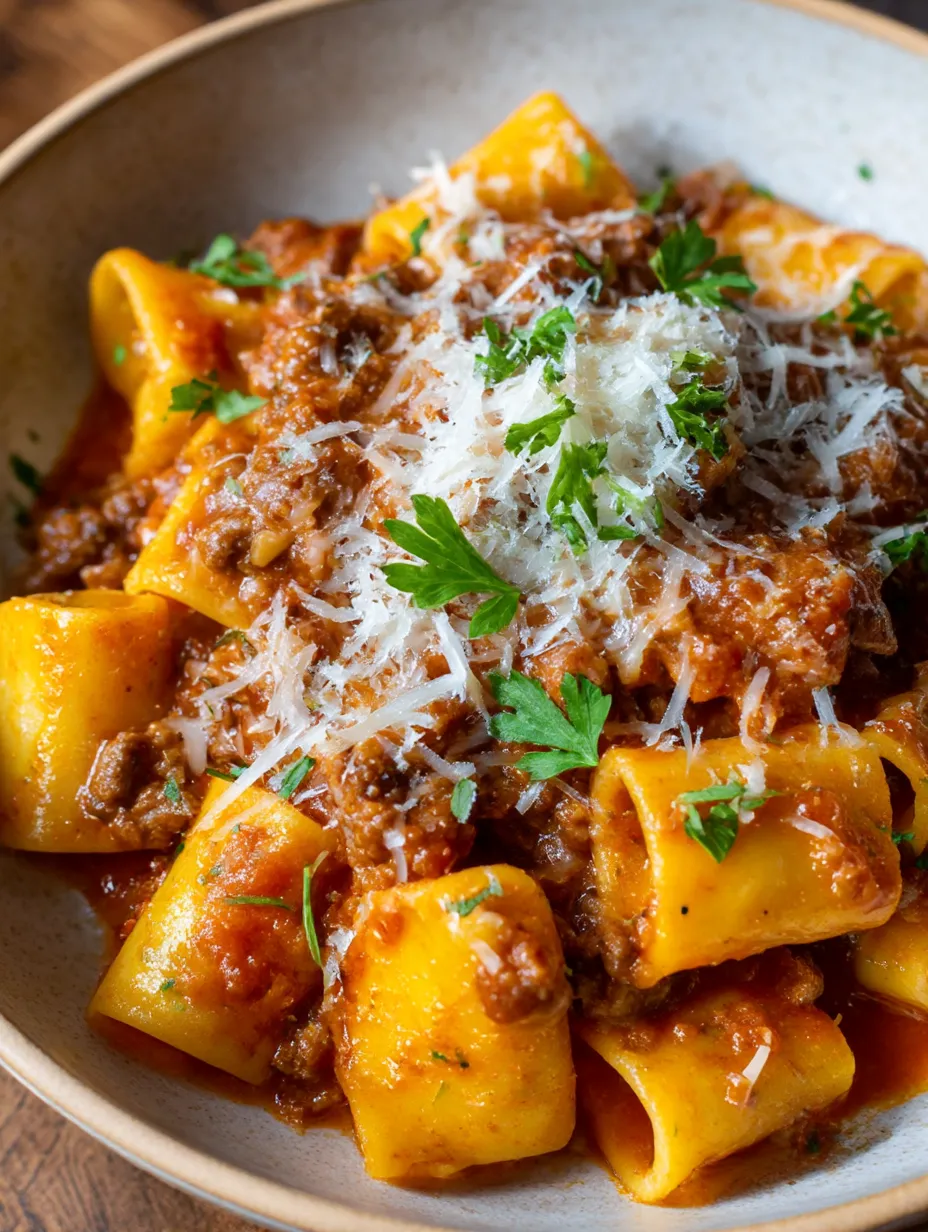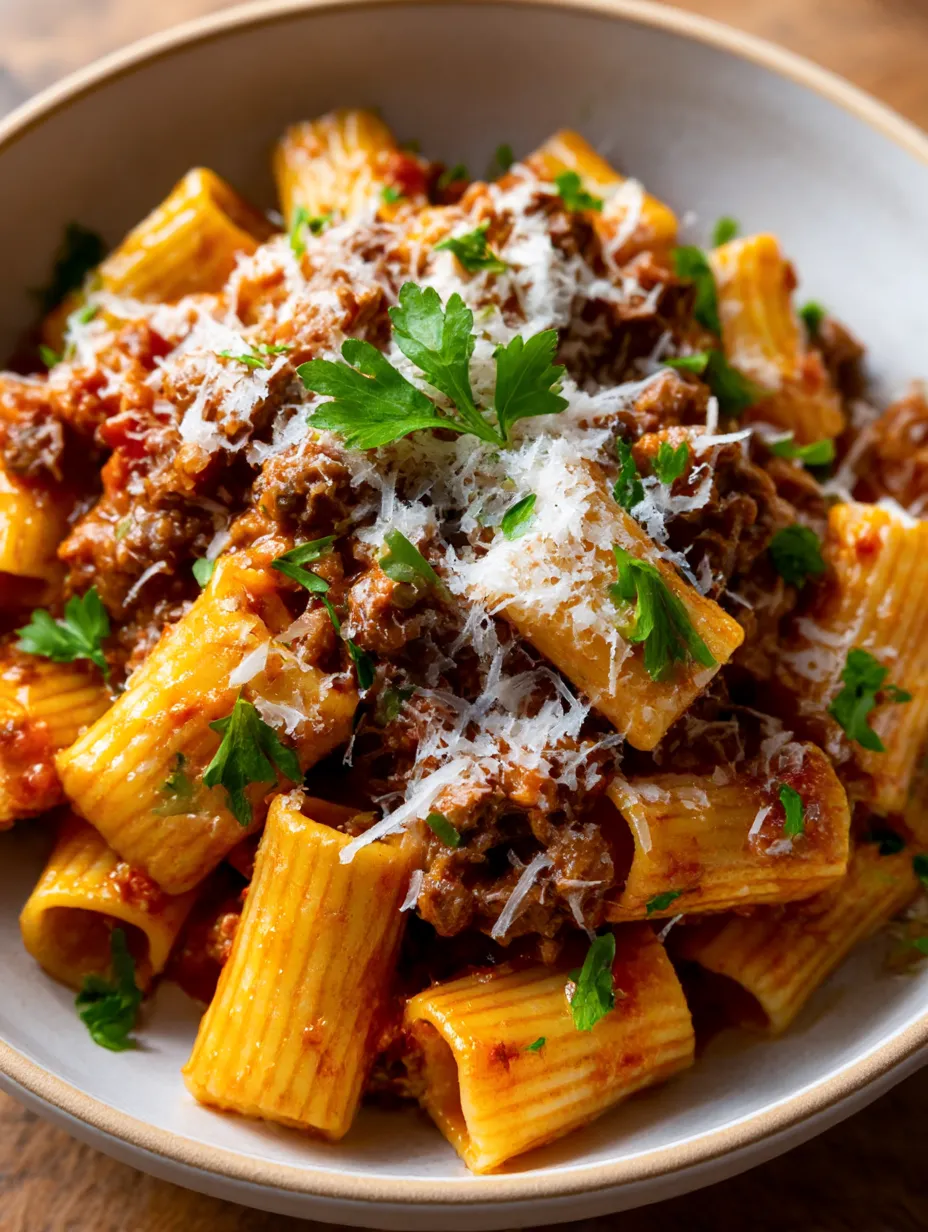 Pin
Pin
This beef and pork ragu is my go-to comfort food when I want something rich and slow-cooked with deep flavors. It is hearty and perfect for a cozy night or when you want to impress family with a rustic Italian meal. The secret lies in slowly simmering the sauce and letting simple ingredients bring their best to the table.
I first made this on a rainy Sunday and fell in love with its savory aroma wafting through the house. This ragu is now the most requested meal at family gatherings and always reminds me of home.
Ingredients
- Lean ground beef: provides hearty flavor and meaty richness Look for beef labeled lean for the best texture
- Ground pork: adds juicy softness and balances the beef Choose pork that is fresh and not pre-seasoned
- Celery carrots and onion: the classics for depth and sweetness Fresh firm and unblemished vegetables work best
- Passata tomato puree: offers a smooth vibrant tomato base Opt for a good quality Italian brand for deeper flavor
- White wine: helps deglaze and build body Use a dry wine you enjoy drinking
- Tomato paste: gives concentrated tomato flavor and a bit of sweetness Go for a thick rich paste
- Oregano: a touch of earthiness Dried oregano works perfectly here
- Salt and black pepper: classic seasoning to balance and sharpen all flavors Use kosher salt and freshly cracked pepper if possible
- Rosemary and thyme tied in a bundle: for herby flavor Always use fresh sturdy sprigs not dried ones
- Parmesan rind: infuses the sauce with a complex cheesy note Save rinds from real Parmesan for the most authentic taste
- Half and half: adds a silky finish and rounds out the sauce Use real dairy for the creamiest result
- Parsley for garnish: a bright fresh finish Pick vibrant green leaves without wilting
Step-by-Step Instructions
- Prepare the Vegetables:
- Finely chop the celery carrot and onion into small even pieces Make sure the vegetables are minced small so they melt into the sauce later
- Brown the Meat:
- Heat a generous swirl of olive oil in a large Dutch oven on medium high Add the ground beef and pork Break up the meat thoroughly with a wooden spoon and keep cooking until you get dark golden crispy bits and almost all moisture has evaporated This can take up to 8 to 10 minutes and it really amplifies the flavor
- Add Aromatics:
- Add in your chopped vegetables and stir well Cook gently for 5 to 7 minutes until the vegetables are completely softened and start to caramelize This forms the flavor backbone of your sauce
- Deglaze and Add Tomatoes:
- Pour in your white wine stirring to scrape any browned pieces from the bottom of the pot Let the wine bubble and reduce by half which should take 3 to 5 minutes Stir in tomato paste and let it cook for about 3 minutes so the raw taste cooks off Next blend in the passata making sure everything is well combined
- Season and Layer Flavor:
- Sprinkle in your oregano salt and black pepper stirring to distribute evenly Lay your bundled rosemary and thyme plus the Parmesan rind right into the sauce so they can infuse as it simmers
- Slow Simmer:
- Turn the heat down to low and let everything gently cook uncovered for at least a full hour Stir it occasionally to keep the bottom from sticking If the sauce gets too thick add a small splash of water Letting this go low and slow is where all the magic happens so do not rush this step
- Finish Creamy:
- Remove the herb bundle and Parmesan rind Taste for seasoning and add more salt if needed Stir in the half and half and let the sauce simmer an extra five minutes for velvety richness
- Serve:
- Spoon generous amounts of the ragu over freshly cooked pasta like tagliatelle or pappardelle and finish with parsley and Parmesan cheese for the ultimate dish
 Pin
Pin
Fresh rosemary is my favorite ingredient here as it gives that wonderful herbal fragrance My grandma used to tuck a little extra thyme sprig into the pot as a special touch and now I always do the same It is a little celebration of memories every time
Storage Tips
This ragu keeps beautifully in the fridge for up to four days Store in an airtight container After reheating the flavors mellow and deepen even more For longer storage freeze in portioned containers for up to three months Thaw in the fridge overnight and rewarm gently on the stove with a splash of water if needed
Ingredient Substitutions
If you cannot find passata use a high quality canned tomato puree Ground turkey or chicken can stand in for beef or pork in a pinch Fresh herbs are best but you can substitute with half the amount of dried herbs if needed For dairy free use a splash of oat milk or omit the half and half
Serving Suggestions
Serve this ragu with sturdy pasta shapes that hold sauce well like pappardelle tagliatelle or rigatoni Top with extra grated Parmesan and torn basil for brightness A crisp green salad and a side of crusty bread complete the meal If you like spice sprinkle with red chili flakes
 Pin
Pin
Cultural Context
Ragu is a traditional Italian meat sauce from northern regions like Emilia Romagna It was always a Sunday meal in my house simmered all afternoon and served to mark special family moments No matter where you are making this sauce brings a little Italian warmth to your table
Recipe FAQs
- → How long should I simmer the meat sauce?
Simmer the sauce uncovered for at least one hour. Longer simmering deepens the flavors and thickens the sauce.
- → Which pasta shapes work best with this sauce?
Wide pasta like tagliatelle or pappardelle complements the hearty, chunky ragu by catching more sauce in each bite.
- → Can I make this sauce ahead of time?
Absolutely. The flavors develop even more after resting. Store cooled sauce in the refrigerator for up to three days.
- → What can I use if I don't have a Parmesan rind?
You can leave it out or substitute with a small piece of hard cheese for added richness. The sauce will still be delicious.
- → How do I adjust the sauce consistency if it’s too thick?
Stir in a splash of water or reserved pasta cooking liquid to reach your preferred texture.
- → Is it possible to freeze this sauce?
Yes, freeze cooled sauce in portions for up to three months, then thaw and reheat on the stovetop for best results.
